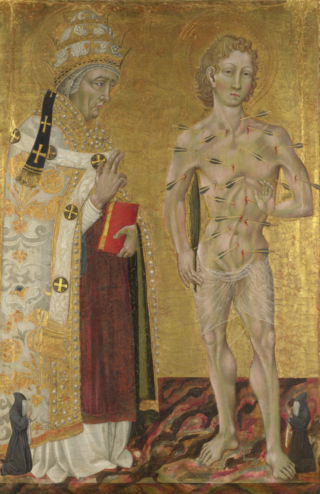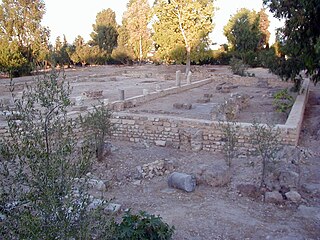Related Research Articles

Pope Stephen I was the Bishop of Rome from 12 May 254 to his death on 2 August 257. He was later canonized as a saint and some accounts say he was killed while celebrating Mass.
Primate is a title or rank bestowed on some important archbishops in certain Christian churches. Depending on the particular tradition, it can denote either jurisdictional authority or (usually) ceremonial precedence.

Pope Hilarius was the bishop of Rome from AD 461 to 468.

Pope Fabian was the bishop of Rome from 10 January 236 until his death on 20 January 250, succeeding Anterus. A dove is said to have descended on his head to mark him as the Holy Spirit's unexpected choice to become the next pope. He was succeeded by Cornelius.

Apt is a commune in the Vaucluse department in the Provence-Alpes-Côte d'Azur region in southeastern France.

The Archdiocese of Lyon, formerly the Archdiocese of Lyon–Vienne–Embrun, is a Latin Church metropolitan archdiocese of the Catholic Church in France. The archbishops of Lyon are also called primates of Gaul. An archbishop is usually elevated by the pope to the rank of cardinal.

The Archdiocese of Aix-en-Provence and Arles is a Latin Church ecclesiastical territory or archdiocese of the Catholic Church in France. The archepiscopal see is located in the city of Aix-en-Provence. The diocese comprises the department of Bouches-du-Rhône, in the Region of Provence-Alpes-Côte d'Azur. It is currently a suffragan of the Archdiocese of Marseilles and consequently the archbishop no longer wears the pallium.
The Archbishopric of Vienne, named after its episcopal seat in Vienne in the Isère département of southern France, was a metropolitan Roman Catholic archdiocese. It is now part of the Archdiocese of Lyon.

The former French Catholic Archbishopric of Arles had its episcopal seat in the city of Arles, in southern France. At the apex of the delta (Camargue) of the Rhone River, some 40 miles from the sea, Arles grew under Liburnian, Celtic, and Punic influences, until, in 46 B.C., a Roman military veteran colony was founded there by Tiberius Claudius Nero, under instructions from Julius Caesar. For centuries, the archbishops of Arles were regional leaders in creating and codifying canon law, through councils and synods.

The Diocese of Grenoble–Vienne-les-Allobroges is a Latin Church diocese of the Catholic Church in south-eastern France. The diocese, erected in the 4th century as the Diocese of Grenoble, comprises the department of Isère and the former canton of Villeurbanne (Rhône), in the Region of Rhône-Alpes. In 2006, the name was changed from the diocese of Grenoble to the diocese of Grenoble–Vienne. The current bishop is Jean-Marc Eychenne, appointed on 14 September 2022.

The Metropolitan Archdiocese of Montpellier (–Lodève–Béziers–Agde–Saint-Pons-de-Thomières) is a Latin archdiocese of the Catholic Church in south-western France. The current metropolitan archbishop is Pierre-Marie Carré; the immediate past Archbishop Emeritus is Guy Marie Alexandre Thomazeau. On September 16, 2002, as part of the reshuffling of the map of the French ecclesiastical provinces, the diocese of Montpellier ceased to be a suffragan of Avignon and was elevated to archdiocese and metropolitan of a new ecclesiastical province, with the dioceses of Carcassonne, Mende, Nimes and Perpignan–Elne as suffragans.

The Archdiocese of Avignon is a Latin archdiocese of the Catholic Church in France. The diocese exercises jurisdiction over the territory embraced by the department of Vaucluse, in the Region of Provence-Alpes-Côte d'Azur. It is named for the prefecture of Avignon. The diocese has been led since January 2021 by Archbishop Georges Pontier, whom Pope Francis called out of retirement to serve as Apostolic Administrator.

The Roman Catholic Archdiocese of Embrun was a Catholic jurisdiction located in southeastern France, in the mountains of the Maritime Alps, on a route that led from Gap by way of Briançon to Turin. It had as suffragans the Diocese of Digne, Diocese of Antibes and Grasse, Diocese of Vence, Diocese of Glandèves, Diocese of Senez and Diocese of Nice. Its see was the Cathedral of Nôtre Dame in Embrun.

The Archdiocese of Chambéry, Saint-Jean-de-Maurienne, and Tarentaise is a Latin Church archdiocese of the Catholic Church in France and a suffragan of the Archdiocese of Lyon. The archepiscopal see is Chambéry Cathedral, located in the city of Chambéry. The archdiocese encompasses the department of Savoie, in the Region of Rhône-Alpes.

The ancient residential diocese of Orange in the Comtat Venaissin in Provence, a fief belonging to the papacy, was suppressed by the French government during the French Revolution. It was revived in 2009 as a titular see of the Catholic Church.
Gaul was an important early center of Latin Christianity during late antiquity and the Merovingian period. By the middle of the 3rd century, there were several churches organized in Roman Gaul, and soon after the cessation of persecution, the bishops of the Latin world assembled at Arles in AD 314. The Church of Gaul passed through three crises in the late Roman period, Arianism, Priscillianism and Pelagianism. Under Merovingian rule, a number of "Frankish synods" were held, marking a particularly Germanic development in the Western Church. A model for the following Frankish synods was set by Clovis I, who organized the First Council of Orléans (511).

The Archdiocese of Carthage, also known as the Church of Carthage, was a Latin Catholic diocese established in Carthage, Roman Empire, in the 2nd century. Agrippin was the first named bishop, around 230 AD. The temporal importance of the city of Carthage in the Roman Empire had previously been restored by Julius Caesar and Augustus. When Christianity became firmly established around the Roman province of Africa Proconsulare, Carthage became its natural ecclesiastical seat. Carthage subsequently exercised informal primacy as an archdiocese, being the most important center of Christianity in the whole of Roman Africa, corresponding to most of today's Mediterranean coast and inland of Northern Africa. As such, it enjoyed honorary title of patriarch as well as primate of Africa: Pope Leo I confirmed the primacy of the bishop of Carthage in 446: "Indeed, after the Roman Bishop, the leading Bishop and metropolitan for all Africa is the Bishop of Carthage."

Justus of Lyon was the 13th Bishop of Lyon. He succeeded Verissimus in the mid-4th century. He is venerated as a saint by both the Catholic and the Orthodox Church, with a feast day on 2 September. Around 350, Justus was made Bishop of Lyon. As bishop of the capital of Gaul, he was among the participants of the Council of Valence of 374 regarding religious discipline of the clergy and the faithful. He later became a hermit.
Marcianus of Arles or Marcion of Arles was the 3rd-century bishop of Arles who later converted to Novatianism. After his conversion, Faustinus, bishop of Lyons denounced him, and Cyprian wrote a letter to Stephen, exhorting the Roman bishop to join in the excommunication of Marcion, so that when he has been excommunicated, another bishop may be elected in his place. However, despite the Gallic bishops denouncing Marcianus, Pope Stephen refused to excommunicate him.
References
- ↑ Archdiocese of Lyon, France at Catholic Saints.info.
- ↑ Bernard Berthod, Jacqueline Boucher, Bruno Galland, Régis Ladous et André Pelletier, Archevêques de Lyon, Lyon, éditions Lyonnaises d'Art et d'Histoire, 2012, p191.
- ↑ Jacques Gadille (dir.), René Fédou, Henri Hours et Bernard de Vregille, Le diocèse de Lyon, Paris, Beauchesne, coll. (Histoire des diocèses de France (no 16), 1983), p350.
- ↑ David M. Cheney, Archdiocese of Lyon at catholic-hierarchy.org.
- ↑ Goyau, Georges. "Lyons." The Catholic Encyclopedia Vol. 9. New York: Robert Appleton Company, 1910. 18 October 2017
- ↑ Lettre de Saint-Cyprien (Epistula LXVIII) adressée au pape Etienne.
- ↑ Gallia Christiana Novissima, Tome III, page 12, n°12.
- ↑ Ducoudray, Gustave (1891). The History of Modern Civilization: A Handbook Based Upon H. Gustave Ducoudray's Histoire Sommaire de la Civilisation. D. Appleton. p. 59. ISBN 978-1-02-244780-6 . Retrieved 11 June 2024.
![]() This article incorporates text from a publication now in the public domain : Herbermann, Charles, ed. (1913). "Lyons". Catholic Encyclopedia . New York: Robert Appleton Company.
This article incorporates text from a publication now in the public domain : Herbermann, Charles, ed. (1913). "Lyons". Catholic Encyclopedia . New York: Robert Appleton Company.